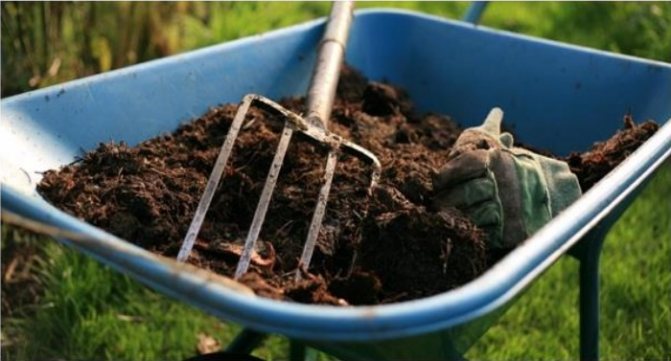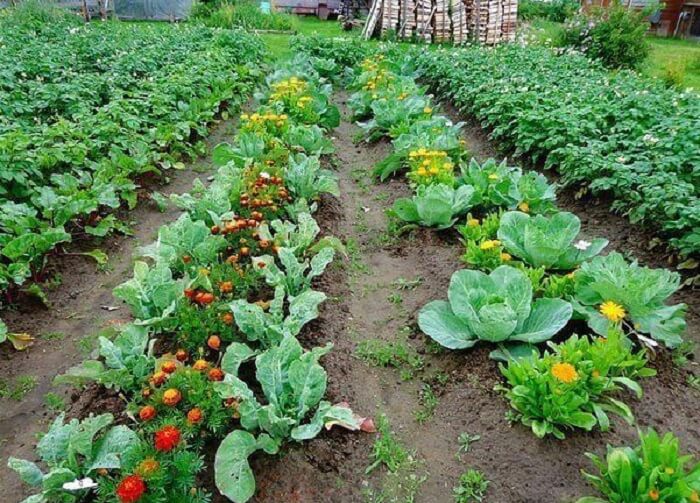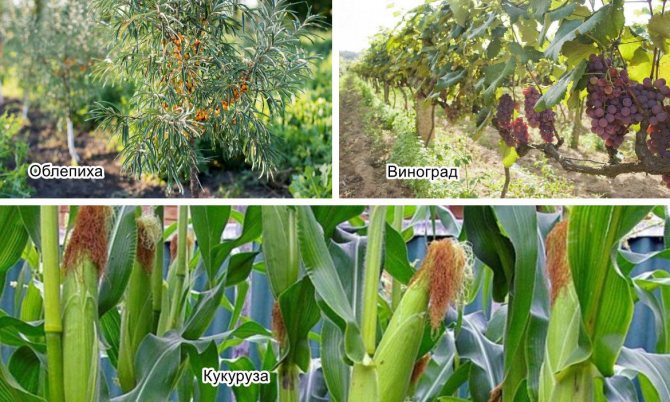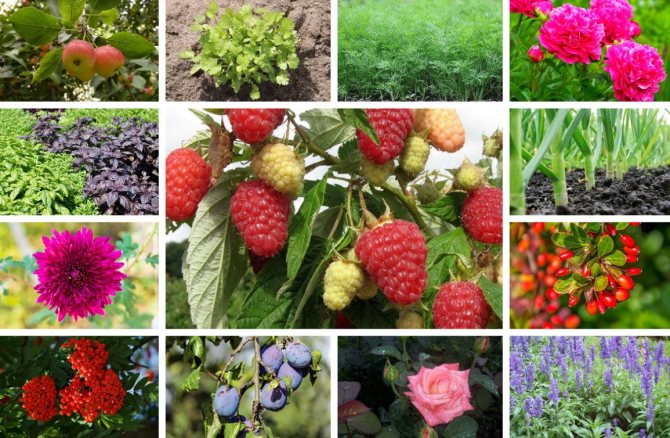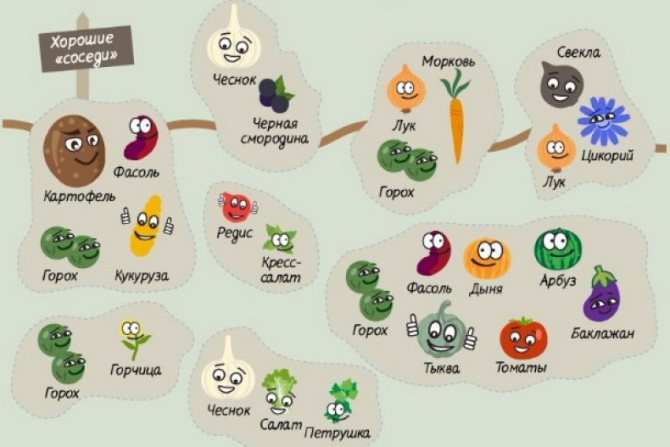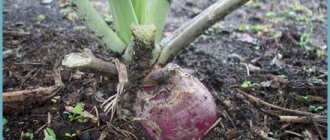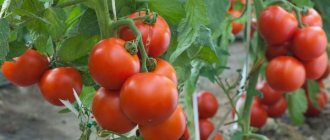Friendly plants
When planting different crops on the same row, it is necessary to take into account the structure of the soil, the irrigation regime and the age of the bushes and the compatibility of the plants. The ripening of the vines is well influenced by cereals and herbaceous plants. Rye, wheat, oats will be useful for grapes. You can plant quinoa and wood lice, they will not interfere.
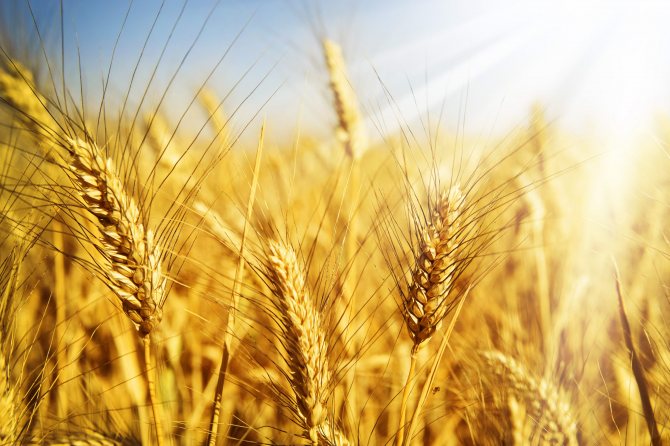
Cereals are good for grapes
If you plant grapes with berries, it will acquire a specific taste. The neighborhood with strawberries will be reflected in the best way. Then the bunches will be well sugared and become larger.
Onions and garlic are great neighbors for any vineyard. They will be able to protect the bushes from pests. But some varieties of onions can be harmful to young bushes.
In the aisles of grapes, varieties of radish, beets and cucumbers grow well. Dill and spinach are also grape-friendly. Sowing legumes will enrich the soil with nitrogen. Some flowers are useful for grapes. Planting of currants and raspberries will take root between the rows of grapes. Currant care can be combined with grape pruning in the fall.
First conclusions
About three years ago, we disbanded a bed with remontant garden strawberries, which was located next to the vineyard. Some of the mustache survived, as they managed to crawl under the vines. There the strawberries took root and grew. She felt great, although the harvest of berries was scanty. Grapes obviously liked the neighborhood with strawberries.
Self-seeding of dill grew well nearby. Apparently, such a neighborhood did not irritate the grapes. The garlic planted side by side was powerful and tall, although its heads were smaller than we expected. It may be a coincidence, but there were no wasps at all on the side of the vineyard where the garlic was.
Eggplants felt the worst of all. The seedlings, planted between the grape bushes, weakened and practically did not increase in size. I had to delete it. Several of the grape bushes under which it was planted are having problems. These unsystematic observations of the joint cultivation of grapes and other crops were the beginning of a serious study of this issue.
The mutual influence of plants is of interest to many gardeners and gardeners. We all know that plants can help their neighbors, make them feel less well, or maintain a neutral relationship. Fierce wars are sometimes fought not only on the surface of the beds, but also underground. Where the roots are. We are not talking about the mass seizure of territories, when the main culture has neither a place nor a normal diet. Even single plants growing nearby can have an effect.
The books by N. Kurdyumov and Lenz Moser helped me to figure out whether it is worth planting grapes together with other crops or keeping it isolated from them. The work "Viticulture in a new way" by the famous Austrian winegrower Lenz Moser confirmed my observations and the reliability of the opinions of familiar Ukrainian and Moldovan gardeners.
In addition, the vast experience of this practitioner made it possible to substantiate bold conclusions. He warned that it is important to take into account the location of the site, the original structure of the soil, the age and nature of the formation of the grapes, the season, climate and many other circumstances.Such a huge amount of factual material has been analyzed that Lenz Moser's experience is credible.
Grape antagonists
Summer residents with experience know which neighbors among plants conflict with each other and which do not. It is very difficult to find out that something was wrong, all processes take place unnoticed by the grower. Only at the end of the season it will be possible to understand that something is wrong. A real war can erupt between root systems for obtaining nutrients. By releasing toxins, neighbors can destroy each other and make the soil unsuitable for the development of young shoots.
Among the vegetables that can harm grapes, there are the following:
- Potatoes
- Eggplant
- Leek (Pearl Onion)
- Corn
- Pepper (red and chilli)
- Tomatoes
- Chives bow


You can not plant corn with grapes
Sorrel and parsley are bad neighbors, they can harm grapes. Some field plants can also interfere with grapes. It is imperative to get rid of dandelions, nettles, cornflowers, plantain and wormwood. It is better not to plant some varieties of flowers near the vineyard: carnations, clematis and calendula. Sunflowers should also not be located near grapes. If you do not take into account compatibility with other plants, plantings may die.
What is best combined with what - a few examples
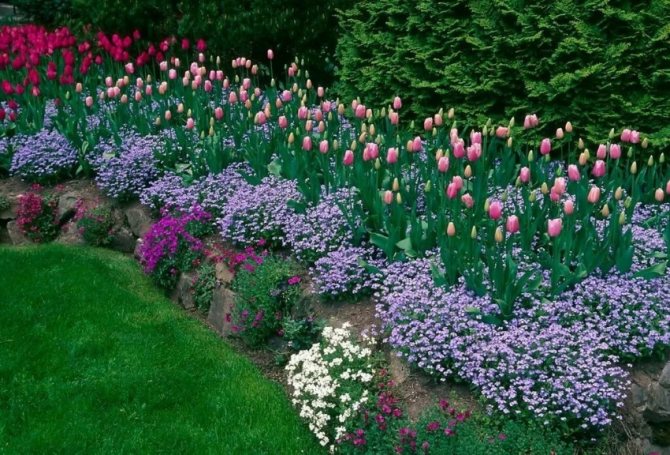

It is simply unrealistic to list all the flowers, so let's talk about the most common plants in the garden. Roses will look bright against the foreground of the conifers. Between them, you can plant the same bright and large crops (phlox, delphiniums) or gentle and discreet (decorative cereals, gypsophila). Climbing roses "make friends" with climbing grapes, the more they can be covered together and treated equally from diseases and pests.
Peonies should be planted on the upper tier, they prefer solitude. But the annuals blooming in front of them will draw attention to themselves after the end of the flowering of the peonies themselves. From ornamental crops, the hosta growing nearby looks beautiful, especially variegated varieties.
Tulips and other representatives of the bulbous family combine with each other and create a bright spring flower bed. They can also be planted in front of or between plants that bloom in summer or autumn (gladioli, chrysanthemums, marigolds).
Irises will "fit" into almost any front garden, with the exception of the rose garden, where they will become visual competitors to the queen of the garden. But beauties - lilies, like peonies, prefer to solo in plantings, but they look good next to the hosts. And chrysanthemums can be considered the most unpretentious in relation to neighbors. They get along well with any flowers, although the flower bed is made of only chrysanthemums, but of different colors, looks gorgeous.
Onions next to grapes
Gardeners often grow onions between rows. The main thing is to fertilize the soil and avoid over-watering the planting. It is necessary to loosen the soil every 10 days. In the fall, it will be possible to harvest. Harvesting is done when the leaves and neck of the plants are dry. The onions will need to be left for 4-5 days to ripen.
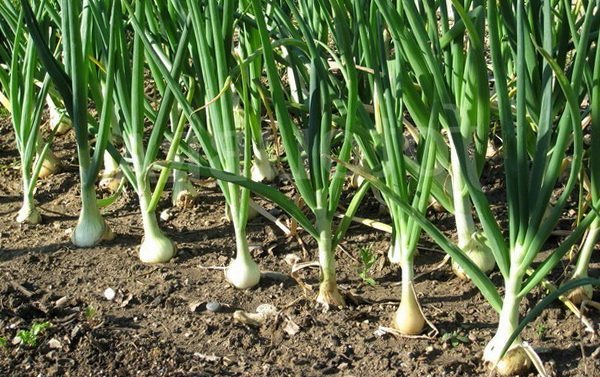

Onions are a good neighbor for grapes
By repeatedly thinning the planting, onions can be grown for greens. Then it can be collected in the summer. Pearl and chives should not be planted near the vineyard.
How to plant cucumbers between trellises
Good neighbors for grapes are cucumbers. One of the best varieties for joint cultivation is the "Relay" variety. It is intended for use in greenhouses, but can also produce crops in open areas.
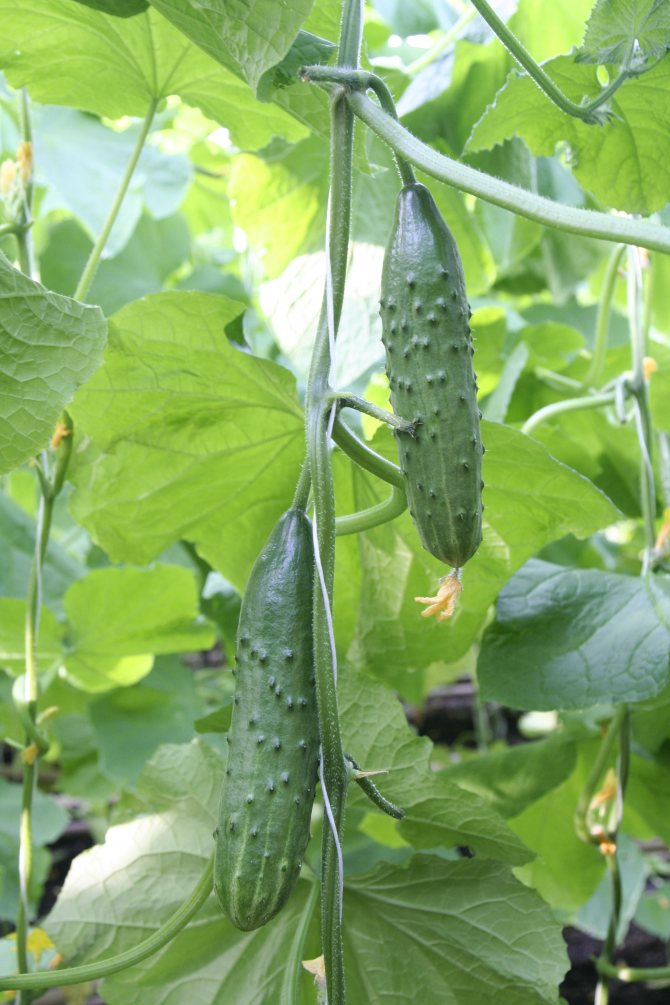

The best variety for joint cultivation relay race
First you need to germinate the seeds of this variety. To do this, they are soaked in a piece of gauze and wait several days. It is necessary to make cones of paper 5 cm in diameter and 10 cm in length. They must be filled with earth and sprouted seeds must be planted there.
The glasses are left in a sunny, warm place. In a few days they will rise.Plants should be planted in glasses in April. At the end of May, they need to be taken out to a shaded place in the fresh air so that they better adapt. In June, you can plant plants in a permanent place. You can fertilize the soil with manure or compost. Landings between the rows are located every 25-30 cm.
Watering should be regular. Half a bucket for one landing. If cared for correctly, the plant will begin to curl around the trellises, reaching a height of 2-3 meters. From 10 such plants it will be possible to harvest 1 kg per day. The season can last until the end of August.
What are the criteria for making a choice?
When choosing a variety, they always pay attention to the characteristics of the variety, the characteristics of fruiting and the timing of ripening. At the same time, one of the important points is missed - the plant's ability to self-pollinate. There are two groups:
- with bisexual flowers;
- with flowering female type.
For crops with flowers of both sexes, the presence of another species nearby is not important, and they are little dependent on insects in terms of fruiting. At the same time, the presence of another species nearby has a positive effect on the yield indicators.
There are varieties for which female-type flowers are characteristic. For them, the work of natural pollinators in the form of insects is important, and planting a number of bushes with bisexual flowers affects them positively. During bad weather, varieties incapable of self-pollination require manual work.
Compatibility
Despite the possibility of planting a number of different grape varieties, it is important to consider a number of important details. Plants have a number of significant differences in terms of breeding qualities, so caring for them can differ significantly. In this regard, the compatibility of varieties should be taken into account when planting plants on the territory that do not differ much in terms of growing and care conditions. Consider the following points:
- requirements for the place and conditions of growing;
- ripening period;
- type of grapes in the form of belonging to the table or technical type;
- features of growth and fruiting.
There are crops with early and late ripening, which require different amounts of heat to ripen. Bushes can differ significantly in shoot height and growth power, some varieties do not require strong support, others can grow up to 2 m. The choice of planting scheme and work with plant feeding depends on these characteristics.
Growing strawberries between rows
The soil between the vines has a high moisture content. Trellises cast a shadow and shelter the earth from increased levels of solar radiation. These factors are ideal for growing strawberries.
Since the roots of grapes and strawberries are located at different depths, competition between the root systems is minimal. Both plants respond positively to organic fertilizers.
Planting strawberries can only be planted between young grape bushes. The distance to the planting should be more than 50 cm. You need to dig a longitudinal hole in the form of an inverted trapezoid. This will keep moisture in the soil. If the humidity is too high, then the bed should be raised above ground level. Installation of a drainage system and drip irrigation will not interfere.
By the third year, it will be necessary to replace the old bed with new plants, re-applying fertilizer. The area of the garden will decrease over time as the grapes grow. The distance to the trellis will increase and will be at least 1 meter.


Planting with strawberries will affect the taste
The strawberry garden is the best place to test watering. The roots of the grapes are deeper than the roots of the strawberries. It is important to distribute the water evenly when watering. Strawberries are a great grape neighbor.
Choosing a place to grow
Grapes are a heat-loving southern plant. Prefers to grow in sunny areas. The best place for planting grapes is the south or southwest side of the site, located near the building.
The southern side of the building heats up from the sun during the day, and in the cool night time it gives off warmth to the grape bushes planted nearby.
The shady side of the site and constant drafts will gradually lead to the loss of seedlings. When choosing a site, it is necessary to provide for the presence of groundwater, make sure that long roots extending to a depth of 8 meters are not washed away by water.
Vine bushes should not grow in the shade of trees. Lush shrubs growing in the neighborhood take nutrients from the soil. The vineyard is best placed on sandy soil. On such lands, grape diseases are less common than on chernozem soils.
Roses
One of the most terrible diseases that can affect huge plots is mildew. Because this fungus is carried by the wind, it can quickly infect and destroy large areas of vineyards. Roses are also susceptible to this disease, but it is less persistent. The rose bush becomes infected one day faster.
In the old days, roses were planted near grapes, since freely grazing horses could inadvertently wander into the site. However, over time, this tradition has lost its relevance and roses have ceased to be planted as a fence. In the middle of the 19th century, an epidemic of another disease, called phylloxera, swept into the vineyards. Only the Occitania vineyard in France survived.
Roses of different varieties can become an indicator of not only diseases. They react to the high content of heavy metals in the soil. Although there are fewer diseases in the north than in the south, preventive treatments should still be carried out. In such cases, the rose bush is the ideal grape neighbor.


Roses are indicators of diseases
Agrotechnics for roses and grapes are the same. Covering is also convenient. It is important to choose a durable material to protect the grapes for the winter. If you choose too thin, then it will break on the thorns of roses.
Flowers should be planted at the end of May when the soil is warmed up. Water the seedlings every two weeks. Proper pruning will allow you to turn the bushes into real works of art.
What does the layout and direction of the rows affect?
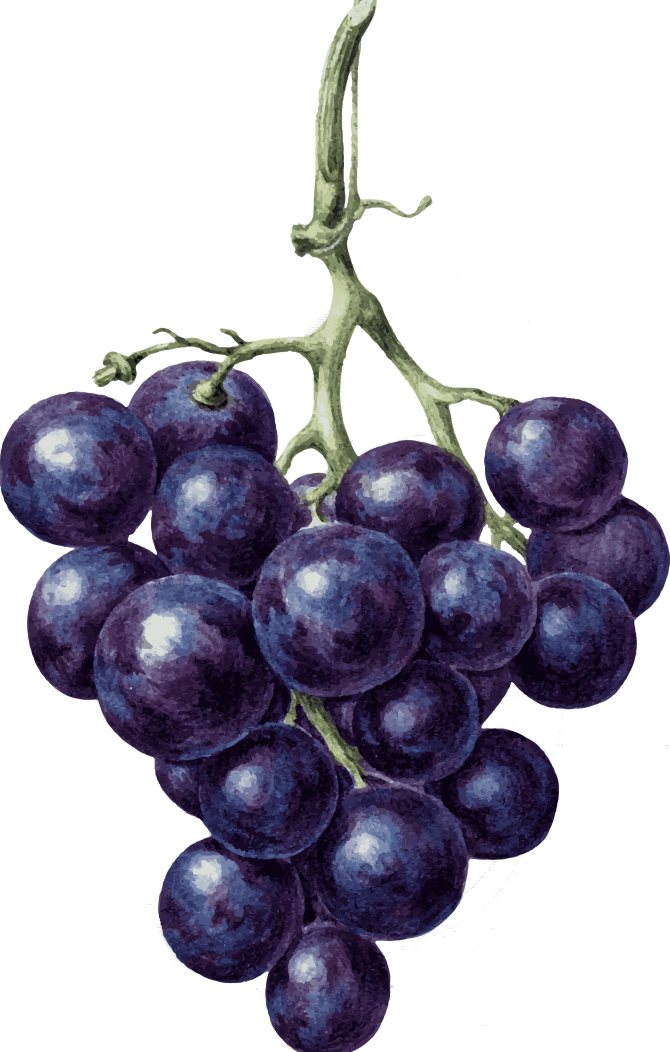

Important! The correct planning of planting grape seedlings allows you to provide a sufficient amount of light and heat, to form and grow large clusters with large fruits.
With an ill-conceived scheme, the development of the vine will slow down, the yield will decrease, and it will be difficult to care for the bushes in the rows.
The optimal direction of the rows is recommended from north to south. At the same time, the seedlings consume light and heat evenly throughout the day. If the rows are located from east to west, the green mass of one row will shade the seedlings of the other row, and the southern side of the rows will receive the most light. In this case, the gap between the planes is kept minimal, the distance between the rows of bushes is reduced.
Weeds
Among the weeds, there are both useful neighbors and pests. If the grape varieties are grown on bare soil, the planting will be severely underdeveloped. This is because weeds act as green fertilizers. Without them, the soil is dry and hardened. After 9-10 years, the planting may die.
Young bushes do not need to be sown with herbs. Weeds will take nutrients from them and prevent them from developing normally. In the third year, you can sow the soil with stunted grasses. Wild weeds can also be left behind. But if flowers of bells or wheatgrass grow in excess, then you need to get rid of them.


There may be grasses between the rows
Weeds also need to be removed with high density shrubs and low formations. If this is not done, then the grapes will die from the fungus when the weeds grow to the level of the bunches. Do not work the soil too close to the trunk, this can lead to damage to the bush.
The most optimal solution is to sow different crops of grass between the rows. This will prevent bad weeds from growing and increase soil fertility.But you can plant herbs only if there is a sufficient area for feeding the bushes.
Unwanted neighborhood in examples
Some growers want others to grow alongside the main crop, such as flowers, herbs and even vegetables.
What plants can be "invited" to grape neighbors so that their coexistence benefits in the form of additional harvest or garden decoration? Let's listen to the recommendations of experienced gardeners and winegrowers, and find out who will become a good friend of a noble berry, and who will become a sworn enemy.
Some plants growing next to grapes have a depressing effect on it, retarding its growth and taking away nutrients. The proximity of others, on the contrary, affects the grapes favorably: it develops better and is less sick.
The renowned winegrower Lenz Moser in his book "Viticulture in a new way" described how he studied in practice the consequences of the coexistence of grapes with 170 different plants, both cultivated and wild.
If the vine grew without neighbors, this did not guarantee that it would be healthy and easily endure the winter. On the contrary, vines, whose aisles were planted with some noble or weedy plants, survived the winter more easily.
Conducting the experiment, Moser weeded part of the control row spacings so that not a single blade of grass grew on them. The other part he cleared of weeds only from March to July, and from August he "forgot" about it. So, the result was simply stunning: the grapes growing on perfectly clean soil were almost twice as slow as their weed-overgrown counterparts.
Based on this experience, Moser advised winegrowers who do not have the opportunity to sow herbs from the list of useful grains near vines, to leave wild weeds if they do not harm the culture.
But if only malicious weeds grow nearby: wheatgrass, sow thistle or bell, it is better to weed them out and plant cultivated plants to the grapes.
It turns out that even one sprout of sow thistle can harm the vine as much as a whole group of harmful weeds.
Neighbors of grapes. Very often the question arises of what can be planted and what cannot be planted near a grape bush. The Austrian scientist Lenz Moser studied this issue in detail. He compiled a classification of friends and antagonists of grapes. It is given below, in parentheses the health score for grapes is indicated.
- sour sorrel (53)
- seed peas (45)
- celandine large (37)
- mustard yellow (28)
- onion (28)
- garden radish (25)
- chard (25)
- pansies (24)
- cauliflower (23)
- radish (22)
- vegetable spinach (22)
- beetroot (22)
- alfalfa (18)
- melon (14)
- strawberry (14)
- carrots (13)
- cucumber (13)
- dill (5)
- white cabbage (5)
- common bush beans (2)
- watercress (2)
- hypnotic poppy (1).
- fennel
- garlic
- kohlrabi
- pumpkin
- creeping clover.
- eggplant (-2)
- St. John's wort (-3)
- shepherd's purse (-3)
- parsley (-6)
- sweet clover (-12)
- physalis (-12)
- meadow clover (-12)
- potatoes (-13)
- pepper (-13)
- thyme (-15)
- celery (-18)
- common caraway (-18)
- fragrant chamomile (-19)
- wood lice (-20).
- dandelion officinalis (-21)
- sunflower (-21)
- wormwood (-21)
- clematis (-21)
- stinging nettle (-23)
- plantain (-23)
- medicinal marigolds (-23)
- meadow bluegrass (lawn grass) (-24)
- cornflower blue (-24)
- sowing hemp (-24)
- elecampane (-25)
- lettuce (leaf) (-25)
- leeks (-28)
- creeping wheatgrass (-28)
- tomatoes (-30)
- chives (-30)
- toadflax (-31)
- tansy (-32)
- large plantain (-33)
- horseradish (-35)
- bird highlander (knotweed) (-35)
- bitter wormwood (-41)
- field bindweed (-41)
- corn (-42)
- black nightshade (late) (-42)
- yarrow (-45).
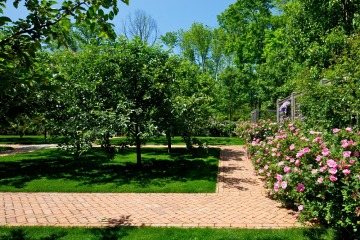

As the cultivation experience shows, there is a new neighbor every year on the garden plot near the grape bushes, today peas, next year potatoes, etc. In such a short period of time, it is unlikely that the positive or negative influence of plants on each other will significantly affect. Another thing is, if grapes and tomatoes grew side by side for several years, then we could say that the discharge into the soil, microflora or other factors of these plants oppress each other. Or plants would grow in a very limited amount of land and air (for example, in a greenhouse).
There are certain doubts about this classification, the most useful plant for grapes is sorrel. A feature of this culture is its adherence to acidic soils, while grapes - to neutral, or even slightly alkaline. A reason to think.
There is a lot of evidence of the joint successful growth of tomatoes, onions, flowers and grapes. So, the degree of reliability of the given classification is left to the discretion of the readers.
In fig. Grapes 1 and 2 (Crimean Pearl variety) in different years coexisted with late white cabbage and calendula without harming the yield of both crops.
Note: When planting vegetable plants or flowers next to grapes, you should take into account the shading factor of each other.
On the one hand, an adult formed grape bush by mid-June forms a shaded place around itself, and not every plant tolerates shade well. On the other hand, tall vegetables (tomato, beans, etc.)
Read next: Neutering rabbits ways at what age do
) themselves are able to shade the grape bush in its lower part. But it is there that there are clusters that do not like shade.
Gardener's advice: Another nuance, grapes require processing with pesticides, especially in June. If you plant garden strawberries next to grapes, which ripens in June, then it will be problematic to process the grapes, because inevitably, some of the pesticides will end up on ripe strawberries. And this is unacceptable.
Therefore, choose a grape neighbor so that they do not interfere with each other, and it is convenient for you.
Important: Whatever the neighbor, it should be placed at a distance of at least 0.5 m from the grapes. Otherwise, carrying out operations with the green parts of the bush, you will inevitably trample these crops.
Prepared by: S. Yu. Sobolev, Candidate of Agricultural Sciences
(Number of views - 2 608, today - 4)
Many gardeners are faced with the fact that the space on the site is becoming less and less, and they want to plant many different crops. I see only two ways out of this situation: either by a strong-willed effort to limit unrestrained desire, or to find some new ways to increase the "opportunities" of the beds. For example, to grow other crops along with grapes.
First conclusions
About three years ago, we disbanded a bed with remontant garden strawberries, which was located next to the vineyard. Some of the mustache survived, as they managed to crawl under the vines. There the strawberries took root and grew. She felt great, although the harvest of berries was scanty.
Grapes obviously liked the neighborhood with strawberries. Self-seeding of dill grew well nearby. Apparently, such a neighborhood did not irritate the grapes. The garlic planted side by side was powerful and tall, although its heads were smaller than we expected.
It may be a coincidence, but there were no wasps at all on the side of the vineyard where the garlic was. Eggplants felt the worst of all. The seedlings, planted between the grape bushes, weakened and practically did not increase in size. I had to delete it. Several of the grape bushes under which it was planted are having problems.
These unsystematic observations of the joint cultivation of grapes and other crops were the beginning of a serious study of this issue.
The mutual influence of plants is of interest to many gardeners and gardeners. We all know that plants can help their neighbors, make them feel less well, or maintain a neutral relationship.
Fierce wars are sometimes fought not only on the surface of the beds, but also underground. Where the roots are. We are not talking about the mass seizure of territories, when the main culture has neither a place nor a normal diet.
Even single plants growing nearby can have an effect.
The books by N. Kurdyumov and Lenz Moser helped me to figure out whether it is worth planting grapes together with other crops or keeping it isolated from them. The work "Viticulture in a new way" by the famous Austrian winegrower Lenz Moser confirmed my observations and the reliability of the opinions of familiar Ukrainian and Moldovan gardeners.
Such a huge amount of factual material has been analyzed that Lenz Moser's experience is credible.
Friends of the grapes
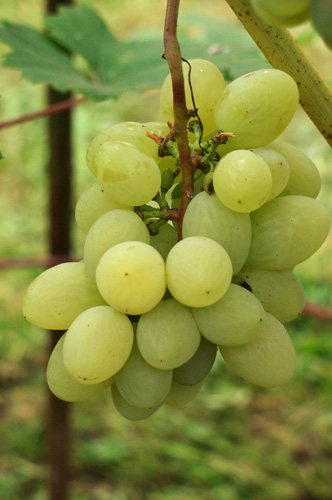

The notion that the grape bush grows best on bare ground is just an old prejudice. ... The grains get along well with the roots of the vine. Low-growing types of clover, vetch, peas, quinoa, veronica and so on are also not harmful. Wood lice, sedum, some mosses even contribute to the growth of the vine.
Asters, arabis (alpine rezuha), aubriezia, horse beans, spring vetch, viola (pansies), gypsophila (kachim), peas, field buckwheat, doriknium, medicinal smoke, melon, strawberries, cereals (many), common groundwort, onions onions, alfalfa, mallow (mallow and neglected), chard, woodlice (zvechatka), forget-me-nots, cucumbers, sedum (white and hare cabbage), purslane, primrose (primrose), radish, soft wheat, mignonette, rye, beets (table and sugar), scorcier (black root), soybeans, prickly tartar (thistle), dill, Drummond phlox, cauliflower, celandine large, vegetable spinach, sorrel, sainfoin, multifoliate ulcer.
Enemies of grapes
Wild field radish, shepherd's purse, field mustard, bells, field thistle, big nettle, carrots, celery, wormwood, bitter wormwood, St. John's wort and others harm the vine.
Amaranth (schiritsa), eggplants, hounds (hairy, black, etc.)
), thistle (sow thistle), blue cornflower, field bindweed, small-flowered galinsoga, Gaillardia, carnation, highlander, medicinal walker, elecampane, calendula (marigold), potatoes, clematis (clematis), nettle (all types), leeks, flax , white gauze, canadian small-petal, cypress euphorbia, hemp, corn, meadow bluegrass, dandelion, parsley, paprika (sweet and bitter), black nightshade, tansy, plantain (large, lanceolate), sunflower, wormwood (common, field, bitter ), millet, creeping wheatgrass, ryegrass, lettuce, rape, tomatoes, yarrow, horseradish, odorous rank, chives, curly sorrel, gray bristles, green (setaria), field shpolka.
Weeds
- Experienced gardeners know that pears that grow next to cherries and cherries are constantly sick, and red and black currants do not grow next to plums, cherries and cherries.
- Currants and gooseberries growing nearby lead to active reproduction of a dangerous pest called the gooseberry moth.
- The apple tree will react negatively if apricot, sweet cherry or cherry grows nearby. Therefore, try to avoid such a neighborhood as much as possible. In addition, apple trees do not like rose, viburnum, lilac and barberry.
- It is better not to plant raspberries and strawberries nearby. Otherwise, the strawberry-raspberry weevil will begin to develop vigorously.
- She will react extremely negatively to any plants that grow next to cherries. Therefore, it is impossible to plant seedlings of other trees next to it in any case.
- It is not recommended to plant birch near growing trees and shrubs. It has a strong root system and absorbs a lot of water. Accordingly, plants that are nearby do not receive this water. Spruce and maple have a similar effect.
- Junipers should not be planted next to a growing pear.
Siderata
Grapes need a special soil structure to grow. The soil is penetrated by plants and their roots. When they die off, cavities will remain in the soil. The root system of the grapes can fill them. The ground part and the dead roots will turn into an excellent fertilizer for the vineyard.
Crops that grow rapidly and give a lot of green mass are used as green fertilizers. Cereals and legumes are most suitable. They can be planted in late summer.
Earthworms are the best indicator of soil quality. If you sow a fast-growing variety of grass on green fertilizer, and then roll it, then an excellent cover is formed. A large number of worms will appear in such soil, and the percentage of humus will increase.
Grasses must be mowed constantly. Tall grass takes the nutrients from grapes that are needed in the spring. After a few years, a humus layer will form from the decayed cut grass. It allows the soil to absorb and distribute moisture better.

